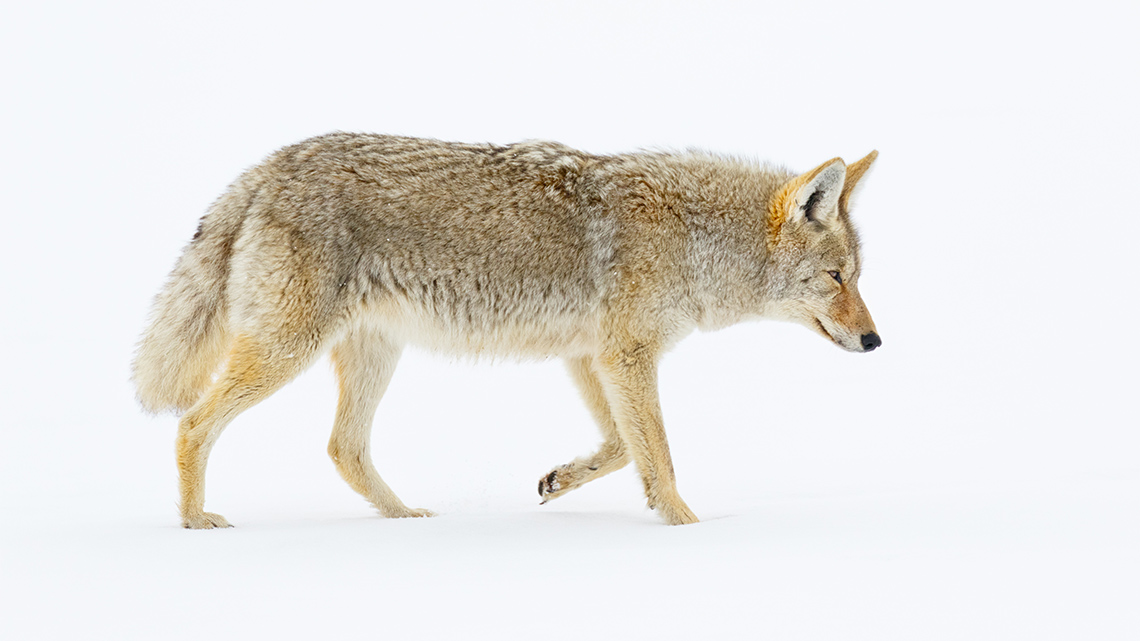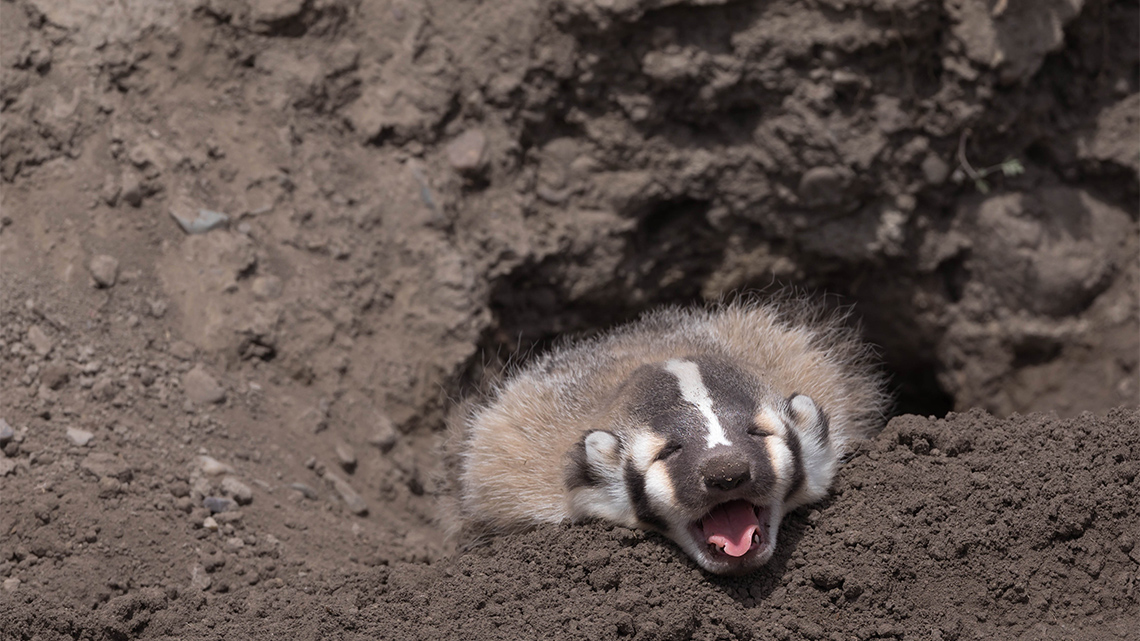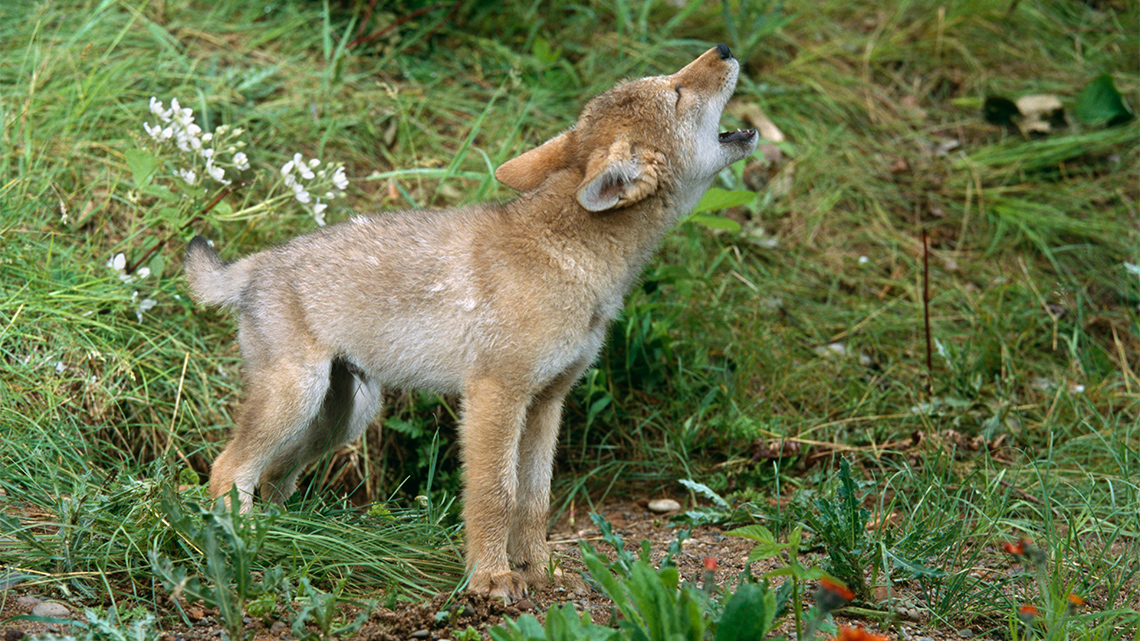Minds On
Who do you depend on?

School days can be very busy. From getting ready in the morning, to working all day in class, to playing sports before going to bed at night, some days are full of activity.
Some people count on others for support during a busy day, like a child needing an adult to drive them to school, or a teacher explaining how to solve a math problem.

Brainstorm
Depending on others
Most people, including adults, depend on someone or something to help them get through their day.
Can you think of someone or something you depend on? Can you think of someone or something that depends on you?
You probably have people or things you depend on. You also may have people or things who depend on you!
Make a list of people or things that you depend on to get you through your day. You may have a family member or a friend who depends on you. Not all things that people depend on must be living. It could be as simple as the water heater that provides hot water for a shower.
How many people, animals, or things depend on you every day?
Record your answers on paper, digitally, or orally. You can use several methods to record your answer, including either the following Number Line or the fillable or printable Number Lines provided.
Try using the following interactive Number Line to record the following two numbers:
- the total number of people or things that you depend on to get through your day
- the number of people, animals, or things that depend on you every day
If you would prefer, you can use the following fillable or printable Number Lines chart instead to record your two numbers.
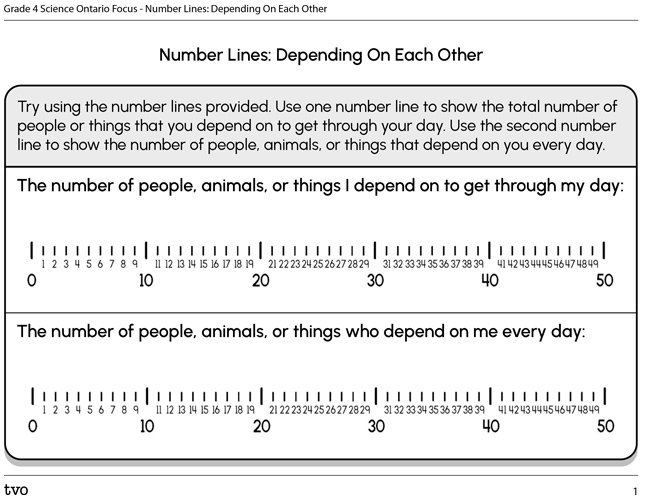
Press the Activity button to access the Number Lines: Depending On Each Other.
Activity (Open PDF in a new tab)Action
Living and non-living things
This learning activity highlights people, places, or innovations that relate directly to the province of Ontario. Enjoy the exploration!

Humans need many non-living things to survive. Think about the air that people breathe or the water people drink. Air and water are non-living things.
Brainstorm
Depending on things
Make a list of some other non-living things that people depend on.
Were any of the following items on the list?
- water
- air
- soil
- sun
- food
- shelter
Animals rely on non-living things as well. Explore the following image of a food chain.

A diagram of a food chain that shows the bottom of the lake with some plants and animals, the surface of the water, and the sun in the sky. Arrows point from the sun to an underwater plant. A snail is eating leaves on the plant. Arrows point from the plant to a small fish, from the small fish to a bigger fish, and from the fish to a blue heron who is dipping his head under the water to catch the fish. The arrows continue, pointing from the heron down to the sandy lake bottom where a skeleton of a heron can be seen. Crabs are on the sand beside the heron. More arrows point from the skeleton to the root system of the plant.
The image you just explored shows a simple food chain. Notice how the sun, which is non-living, begins the food chain. The sun provides the water plants with energy, which becomes food for a snail, which becomes food for a small fish, which then becomes food for a larger fish, and so on. In this food chain diagram, how many animals depend on the non-living sun for survival?
Select the correct answer, then press ‘Check Answer’ to see how you did.
Interdependence
During Minds On, you recorded your thoughts around who and what you depend on for survival and who depends on you. Let’s take a closer look at this community. A community is a group of living things in a habitat that depend upon each other for survival. You may have mentioned that you depend on an adult to provide you with a warm home and food to eat. You may have younger siblings or pets that depend on you.
Altogether, you are part of a larger community.
Let’s look at a different community, one from a natural habitat. Have you ever seen a badger or a coyote?
A badger is a short-legged furry mammal that can be found in many places around the world. Some badgers are brown or golden, while others are gray or black. North American badgers are gray and have a distinctive black and white striped face. North American badgers are smaller than European badgers. Badgers eat both plants and meat. They are very good diggers, and use their strong muscles and sharp claws to dig burrows and find food underground.
Coyotes are a relative of dogs and wolves that are about as big as a medium-sized dog. They can be found all over North America. Coyotes are not picky about food. They hunt and eat small prey like rabbits, squirrels, and mice. They will also eat insects and fruit, as well as garbage and food left out by humans.
Badgers and coyotes are both animals that can be found in Ontario.

A map of Ontario showing small badger populations in southwestern Ontario mostly along the north shore of Lake Erie, and in northwestern Ontario near the border with the United States of America.
North American badgers are an endangered species. They are found in Southwestern Ontario, mostly along the North shore of Lake Erie, and in one small part of Northwestern Ontario.

A map of Ontario showing where you can find coyotes. Coyotes are found in abundance all over the southern half of Ontario from east to west.
What do a badger and a coyote have to do with one another? These two animals rely on each other in a very interesting way.

Both the coyote and badger rely on each other, because they both like to eat groundhogs. The larger coyote chases prey on the grassland. The smaller badger hides in groundhog burrows, waiting for the groundhogs to return home. The coyote chases the groundhog and hopefully catches it. If the coyote is not lucky, the groundhog goes to its home, where the badger is waiting for it. Caught between two predators, the groundhog becomes a meal for one of them. The complementary hunting strategies used by these two animals increases the chances of getting food for both species, and ensures that at least one of them will eat.
Press ‘Complementary’ to learn its definition.
Complementary means to help out or complete something or someone else, and to have them help you, too. For example, the coyote helps the badger, and the badger helps the coyote.
These two animals depend or rely on each other. This is an example of interdependence; how living or non-living things can depend on each other. Badgers and coyotes are part of a community, which is a group of interacting species that share a common habitat. The groundhog and the grass the groundhog eats are all part of the same community.
What do you think might happen if either the coyote or badger was no longer in this habitat?
Record your answer in a method of your choice.
Press ‘Interdependence’ to access its definition.
Interdependence is when people, animals, or living or non-living things depend on each other.
Interdependence among living things
Living things also depend on other living things for help. Earlier in the learning activity, we learned how the coyote and badger rely on each other when hunting for food.
There are three ways (or methods) in which living things depend on each other.
Explore the following images and descriptions as clues to determine the different methods of interdependence.
Investigate
Observe and ask questions
Let’s investigate the following images.
Sometimes, our observations don’t tell us enough and we need to stay curious and ask many questions.
A carousel of three images.
Image 1: A line of images starting with a leaf, followed by an arrow pointing to a caterpillar, followed by an arrow pointing to a bird.
Image 2: A line of images starting with a bee collecting nectar from a flower with its tongue. As the bee feeds, it gets covered in pollen. The pollen-covered bee then flies from one flower to another. As the bee feeds from the second flower, it leaves pollen behind.
Image 3: A bird sitting on a branch that is laying on the ground on a forest floor. The bird has a red-colored seed in its beak.
Use the information you gained from the previous images to select the missing word from the drop-down menu and complete each sentence.
Press the following tabs to learn more about the three different ways in which living things depend on each other illustrated in the preceding pictures.
Food
Food is one way that animals depend on other animals.
Each of the organisms in the food chain are dependent on one another for survival.
Pollination
When insects interact with flowers, they pick up pollen on their bodies. When the insects then visit other plants, they spread the pollen around. This pollen fertilizes the plant, allowing it to grow fruit, nuts, and more flowers. Pollination is another way living things depend on each other for survival.
Spreading seeds
Some plants sprout from seeds. Animals such as birds help spread the seeds away from the parent plant, making sure that new plants grow and survive in a new area. Wind also helps with this process of dispersing seeds.
Pause and Reflect
Honeybees
There is a tiny parasite causing the deaths of many honeybees in Ontario. What do you think is the effect of the loss of bees on the other members of its habitat? Recall your learning about pollinators and seeds.
Record your answer in a method of your choice. Where possible, share your thoughts with others.
Consolidation
Survival requires interdependence
All plants and animals, including humans, depend or rely on something else to survive.
This interdependence, or relying on another living or non-living thing, ensures the survival of organisms.
Examine the following image or visit a nearby park or school yard. Take a piece of paper and pencil or audio/video recording device and make a list of all the living and non-living things you encounter. You can also record your findings in the fillable and printable document that follows.
Safety reminder
Always be sure to check with an adult before going exploring.
Before beginning your research, explore the following video that explains the scientific research process. This will help guide you as you work your way through this activity.
Check out the following video to learn about the steps of the Scientific Research Process.

A person walks a dog in a park. In the park, you can find a bench, rocks, swings, a slide, a garbage bin, a racoon eating something out of the garbage bin, a streetlight, plants, trees, insects, flowers, a squirrel, a bird, and a bird’s nest with baby birds in it.
Living or non-living?
Use the following checklist to determine if the things you encounter are living or non-living. If the thing does any of the following actions, it is a living thing!

Are there more living or non-living items?
How are the living and non-living items similar or different?
Knowing what the difference is between living and non-living things helps clarify how they are dependent on each other for survival.
Complete the The Interdependence of Living and Non-Living Things in your notebook or using the following fillable and printable document. If you would like, you can use speech-to-text or audio recording tools to record your thoughts.
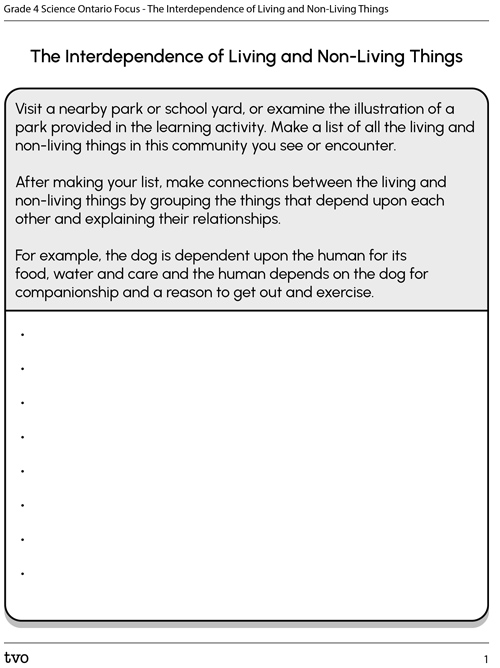
Press the Activity button to access the The Interdependence of Living and Non-Living Things.
Activity (Open PDF in a new tab)Pause and Reflect
Communities
Did I…
How does a change in the community you observed affect the rest of the members of that community — including humans, if there are any?
Reflection
As you read through these descriptions, which sentence best describes how you are feeling about your understanding of this learning activity? Press the button that is beside this sentence.
I feel…
Now, record your ideas using a voice recorder, speech-to-text, or writing tool.

